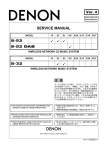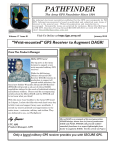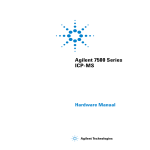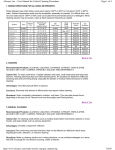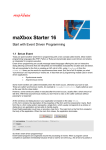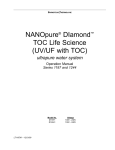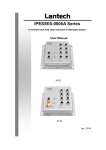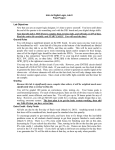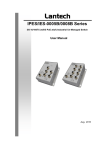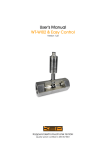Download Cleaning Procedures in ICP-MS Laboratories
Transcript
Air Quality Research Division / Division de la recherche en qualité de l'air Analysis and Air Quality Section / Section des analyses et de la qualité de l’air 335 River Rd, Ottawa, ON K1A 0H3 Title: Cleaning Procedures in ICP-MS Laboratories Copy No: ## SOP No.: 6.13/2.3/S Location: ### Effective Date: July 23, 2013 QSM Approval: _______________ Cleaning Procedures in ICP-MS Laboratories 1. INTRODUCTION and SCOPE 1.1. This Standard Operating Procedure provides instructions for cleaning of the regular labware, microwave digestion vessels and instrument parts, used in ICP-MS laboratories of the Particulate Characterization Unit, Analysis and Air Quality Section, conducting trace metal analysis. 2. CLEANING SOLUTIONS 2.1. Water: There are two types of deionized water in the lab: deionized water (DW) which is used for initial rinsing and for preparation of cleaning solutions, and the double deionized water (DDW) with resistivity >18 MOhm cm which is used for final rinsing of labware and preparation of standards and samples. 2.2. 5% (v/v) Citranox solution (Alconox, Inc.) prepared in DW. 2.3. 5% (v/v) HNO3 bath prepared in DW. 3. REGULAR LABWARE CLEANING 3.1. Regular labware includes 3.1.1. Polypropylene and polymethylpentene volumetric flasks (including the caps) that are used to prepare standard and sample solutions. 3.1.2. High density polyethylene bottles, polypropylene bottles and Teflon FEP and PFA bottles (all bottles and caps) that are used for the storage of diluted acids, standard and sample solutions. 3.1.3. Polypropylene sample preparation tubes (with caps) and autosampler vials, polymethylpentene graduated cylinders, Teflon beakers, and some glass beakers used when instrument maintenance is performed. 3.2. Cleaning procedure of the regular labware 3.2.1. Rinse new or used regular labware with DW a couple of times. 3.2.2. Soak labware in 5% (v/v) Citranox solution for at least one hour (better overnight), and ensure all inner surfaces of the labware are in contact with the detergent. The 5% (v/v) Citranox solution is prepared fresh as needed, depending THIS DOCUMENT MUST NOT BE PHOTOCOPIED Any hard copies of this document missing any pages, or without a copy number and the initials of the Quality Systems Manager is uncontrolled. Any electronic copy of this document anywhere but on SharePoint is uncontrolled. DO NOT USE THIS DOCUMENT FOR OPERATIONAL PURPOSES IF IT IS AN UNCONTROLLED COPY Page: 1 of 6 Air Quality Research Division / Division de la recherche en qualité de l'air Analysis and Air Quality Section / Section des analyses et de la qualité de l’air 335 River Rd, Ottawa, ON K1A 0H3 Title: Cleaning Procedures in ICP-MS Laboratories Copy No: ## SOP No.: 6.13/2.3/S Location: ### Effective Date: July 23, 2013 on the extent of usage. Record the date of solution preparation in the designated log. 3.2.3. Rinse labware with DW at least 3 times and ensure the entire inner surface is rinsed. 3.2.4. Soak labware in 5% (v/v) HNO3 bath for at least one hour followed by further rinsing with DDW. Acid bath should be prepared fresh as needed, depending on the extent of usage. Record the date of bath preparation in a designated log. 3.2.5. The volumetric flasks should be caped and stored after cleaning without drying. Before use, the volumetric flasks and the caps should be rinsed with the acid matrix (e.g., 1% (v/v) HNO3, depending on application) at least once. 3.2.6. After cleaning, all other labware should be dried in Labconco Trace Metal (TM) Work Station (Consult manufacture’s manual for operation instructions) which provides Class 100 air. 3.2.6.1. Turn on Labconco TM Work Station, if it is not already ON, and let it run unobstructed for about 15 minutes. 3.2.6.2. Move the cleaned labware into the TM Work Station, place them far inside (at least 4 inches from the front) and let dry. 3.2.7. The dried bottles should be capped in the TM Work Station and then stored on the designated shelf. 3.2.8. The dried autosampler vials should be stored in a clean plastic box with a lid. 3.2.9. The dried sample preparation tubes should be capped in the TM Work Station and then stored in a clean plastic box with a lid. 3.2.10. The dried Teflon beakers and graduated cylinders should stay in the TM Work Station. 3.2.11. The dried glass beakers should be stored on the designated shelf. 3.2.12. Before use, the storage bottles and the autosampler vials should be rinsed with the solution at least once, if applicable. 4. CLEANING OF MICROWAVE DIGESTION VESSELS SET USING THE TraceClean UNIT 4.1. The microwave vessels set consist of the Teflon vessel, vent plug and cap. New or used microwave digestion vessel sets should be cleaned before use. THIS DOCUMENT MUST NOT BE PHOTOCOPIED Any hard copies of this document missing any pages, or without a copy number and the initials of the Quality Systems Manager is uncontrolled. Any electronic copy of this document anywhere but on SharePoint is uncontrolled. DO NOT USE THIS DOCUMENT FOR OPERATIONAL PURPOSES IF IT IS AN UNCONTROLLED COPY Page: 2 of 6 Air Quality Research Division / Division de la recherche en qualité de l'air Analysis and Air Quality Section / Section des analyses et de la qualité de l’air 335 River Rd, Ottawa, ON K1A 0H3 Title: Cleaning Procedures in ICP-MS Laboratories Copy No: ## SOP No.: 6.13/2.3/S Location: ### Effective Date: July 23, 2013 4.1.1. Rinse the vessels, vent plugs and caps at least 3 times with plenty of DW. Soak them overnight in 5% (v/v) Citranox solution and rinse them thoroughly with DW. 4.1.2. Soak the vent plugs and caps overnight in 5% HNO3 solution. Rinse them thoroughly with DDW and let them dry in the Labconco TM Work Station. Store the vent plugs and caps in the designated clean box covered with lid. 4.1.3. Clean the digestion vessels using the TraceClean unit 4.1.3.1. Turn on the power of water cooler for the unit. The operation temperature is set at 10°C and it will take about 10 minutes for the water to reach it. 4.1.3.2. Switch on the unit and lift up the vessel holder by pressing the button on the left-hand side of the control terminal and the left potentiometer simultaneously. 4.1.3.3. Take extreme caution when loading and unloading the unit because the container lid is covered with concentrated HNO3 droplets. Wipe it with a paper towel. Read Safety Rules in the TraceClean User Manual carefully. 4.1.3.4. Hang vessels onto the vapor tubes with opening down. At least 6 vapor tubes must be filled with vessels. Empty tubes must be stopped with blind stoppers. 4.1.3.5. Lower the container cover until the lift stops by pressing the button on the left-hand side of the control terminal and the right potentiometer simultaneously. 4.1.3.6. Press the left potentiometer for approx. 0.5 sec. Turn it to go through the existing programs (P1 to P9) and select the cleaning program by pushing it. Select the program P1 “Routine_1” which cleans the vessels for 1 hour at 500°C. P1 “Routine_1” 01:00:00 500oC 4.1.3.7. Press both potentiometers simultaneously for approx. 1 second to start the operation. The following display will appear showing the information on the remaining time and current temperature: Remain time 00:50:30 Temp 300oC THIS DOCUMENT MUST NOT BE PHOTOCOPIED Any hard copies of this document missing any pages, or without a copy number and the initials of the Quality Systems Manager is uncontrolled. Any electronic copy of this document anywhere but on SharePoint is uncontrolled. DO NOT USE THIS DOCUMENT FOR OPERATIONAL PURPOSES IF IT IS AN UNCONTROLLED COPY Page: 3 of 6 Air Quality Research Division / Division de la recherche en qualité de l'air Analysis and Air Quality Section / Section des analyses et de la qualité de l’air 335 River Rd, Ottawa, ON K1A 0H3 Title: Cleaning Procedures in ICP-MS Laboratories Copy No: ## SOP No.: 6.13/2.3/S Location: ### Effective Date: July 23, 2013 4.1.3.8. The application is ended when the remaining time has reached 00:00:00. If the application has to be terminated before, press simultaneously both potentiometers. 4.1.3.9. After the program run, is possible to lift up the container cover only when the temperature of heating plate is 100°C or less. Press the right potentiometer to display the actual temperature and decide when to unload the unit. 4.1.3.10. Lift the cover about 1 cm to allow any NOx and remaining HNO3 to be evacuated from the chamber before opening it completely. Be sure that the exhaust is in function when performing this step. 4.1.3.11. Take out the cleaned vessels using the proper safety equipment such as safety goggles, gloves and labcoat. Close the unit again. 4.1.3.12. Record the dates the unit was used in the appropriate logbook. Since a loss of approximately 25 mL of acid per run can be expected, the system should be checked every 3 to 5 days, as needed. The acid will need to be changed every 3 to 6 months or whenever contamination is suspected (Consult the User Manual for TraceClean system handling). 4.1.4. Rinse the microwave digestion vessels thoroughly with DDW, let them dry in the Labconco TM Work Station and store in a clean designated box covered with lid. 5. CLEANING OF THE ICP-MS PARTS 5.1. The ICP-MS parts are cleaned according to the run-times recommended in the hardware manuals, during regular maintenance of the instrument or when problems are noticed in the normal performance of the instrument. 5.2. Most of the cleaning procedures are those recommended by the manifacturer, with the exception of the following: 5.3. Cleaning the torch: 5.3.1. Place the torch in an wide-mouth Teflon container and add aqua regia solution 5.3.2. Place this container inside a glass wide-mouth beaker filled with tap water and keep them on a hot plate for 35-40 min. Caution: this procedure should be performed in a well-ventilated fume-hood 5.3.3. After the solutions are cooled down for about 1 hour inside the fume-hood, rinse the torch with plenty of DDW and let it dry in Labconco TM Work Station THIS DOCUMENT MUST NOT BE PHOTOCOPIED Any hard copies of this document missing any pages, or without a copy number and the initials of the Quality Systems Manager is uncontrolled. Any electronic copy of this document anywhere but on SharePoint is uncontrolled. DO NOT USE THIS DOCUMENT FOR OPERATIONAL PURPOSES IF IT IS AN UNCONTROLLED COPY Page: 4 of 6 Air Quality Research Division / Division de la recherche en qualité de l'air Analysis and Air Quality Section / Section des analyses et de la qualité de l’air 335 River Rd, Ottawa, ON K1A 0H3 Title: Cleaning Procedures in ICP-MS Laboratories Copy No: ## SOP No.: 6.13/2.3/S Location: ### 5.4. Effective Date: July 23, 2013 Cleaning the Babington nebulizer: 5.4.1. Remove the O-rings and place the nebulizer in a MeOH bath for 10 min 5.4.2. Rinse and sonicate the nebulizer with DDW for 10 min 5.4.3. Rinse it with plenty of DDW and let it dry in Labconco TM Work Station 5.5. Cleaning the spray chamber 5.5.1. Soak the spray chamber in 5% (v/v) Citronex bath for at least 1 hr 5.5.2. Rinse it with plenty of DDW and soak overnight in 5% (v/v) HNO3 bath 5.5.3. Rinse it with plenty of DDW and let it dry in Labconco TM Work Station 6. APPLICABLE SOPs SWP-001/*.* “Safe Working Procedures and Policies” 7. REVISIONS August 2005: Author, Heidi Chen. New document 6.13/1.0/S April 2007: Valbona Celo, Irina Okonskaia (Revision 6.13/2.0/S) Title is changed; Section 1.1: the scope is broadened to include the instructions for cleaning of instrument parts; Section 2 is divided in two sub-sections: Section 2 which describes the cleaning solutions only and Section 3 which describes the regular labware cleaning procedures; cleaning solutions are changed from 10% (v/v) Citranox to 5% (v/v) Citranox and 5% (v/v) HNO3 ; Sections 2.4 is added; Section 2.2, 3.1.1.1.1 and 3.2.1: soaking in 10% (v/v) HNO3 bath is changed to 5% (v/v) Citranox bath; Section 2.5 is changed; Sections 3.2.2 to 3.2.4 are added; Section 3 is re-arranged and condensed by removing details which are included in the SOP 6.12/*.*/S; Section 3.1.2.1: microwave cleaning with 10% (v/v) high purity HNO3 is changed to 15% (v/v) high purity HNO3; Section 3.1.2.4: the microwave digestion program for cleaning is changed from EPA3051.PGM to the corresponding samples microwave digestion program; Section 5: cleaning of ICP-MS parts is added. April 2009: Valbona Celo, Irina Okonskaia (Revision 6.13/2.1/S) Section 4 is changed from the microwave assisted acid cleaning of digestion vessels to the acid vapor cleaning using the TraceClean unit May 2011: Valbona Celo Section 2.1: the specifications of deionizing systems are removed and the required resistivity for the DDW is added; Section 6: removed SOPs 6.12/*.*/S and 6.15/*.*/S THIS DOCUMENT MUST NOT BE PHOTOCOPIED Any hard copies of this document missing any pages, or without a copy number and the initials of the Quality Systems Manager is uncontrolled. Any electronic copy of this document anywhere but on SharePoint is uncontrolled. DO NOT USE THIS DOCUMENT FOR OPERATIONAL PURPOSES IF IT IS AN UNCONTROLLED COPY Page: 5 of 6 Air Quality Research Division / Division de la recherche en qualité de l'air Analysis and Air Quality Section / Section des analyses et de la qualité de l’air 335 River Rd, Ottawa, ON K1A 0H3 Title: Cleaning Procedures in ICP-MS Laboratories Copy No: ## SOP No.: 6.13/2.3/S Location: ### July 2013: Effective Date: July 23, 2013 Valbona Celo Sections 3.2.2 and 3.2.4: The frequency of preparing the fresh solutions for the Citronex and HNO3 baths is removed and “prepare as needed, depending on the usage” is added; Section 5: Reference to Agilent 7500 ICP-MS Hardware Manual id removed and amore general statement is added; References: 1. Agilent Technologies, Agilent 7700 Series ICP-MS Hardware Manual, June 2009, Tokyo, Japan is added 8. REFERENCES 1. NANOpure DIamond UV ultrapure Water System, Operation Manual, Series 1191, 2000, Barnstead| Thermolyne, IA, USA 2. 3 Foot Purifier Total Exhaust Clean Bench Trace Metal Analysis Work Station, Instruction Manual, Rev. B, 1999, Labconco Corporation, Missouri, USA 3. Agilent Technologies, Agilent 7500 ICP-MS Hardware Manual, January 2001, Tokyo, Japan 4. Agilent Technologies, Agilent 7700 Series ICP-MS Hardware Manual, Tokyo, Japan June 2009, 5. TraceClean User Manual- Revision 7/2006 Lead reviewer: Valbona Celo Title: Supervisor, Particulate Characterization Unit Approved by: Ewa Dabek Title: Head, Particulate Characterization Unit THIS DOCUMENT MUST NOT BE PHOTOCOPIED Any hard copies of this document missing any pages, or without a copy number and the initials of the Quality Systems Manager is uncontrolled. Any electronic copy of this document anywhere but on SharePoint is uncontrolled. DO NOT USE THIS DOCUMENT FOR OPERATIONAL PURPOSES IF IT IS AN UNCONTROLLED COPY Page: 6 of 6






